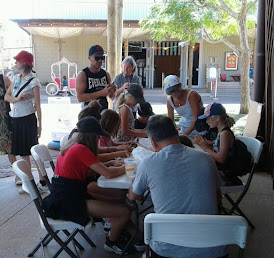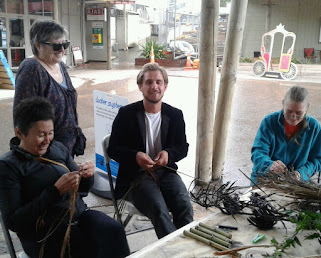WATER SYSTEMS
BIRD AND INSECT BATH, ceramic, about 1 metre high Sculpture On The Gulf 2022, Waiheke Island
Bird and Insect Bath and Safe Haven are sculptures to give water, food and shelter to birds and insects over the hot
summer. Tunnels wind through the interior of the
sculpture providing small creatures with shelter. Shallow pools dot the surface
where water can be held. Other indentations are deeper and hold earth where
flower seeds are planted. The Bird and Insect Bath installation is interactive with wobbly little water containers provided for people to water the sculpture with.
These sculptures are part
of my ongoing project Water Systems. Water Systems forms a point of mediation
and meditation between the natural world and the human built world. The core
kaupapa is to bring people closer to the environment and its creatures - to
restore a sense of guardianship towards nature, to recognise the mauri of other animals.
SAFE HAVEN, ceramic, about 800mm high Sculpture In The Gardens 2021, Auckland Botanic Gardens
DETAILS
ANGLES OF A CURVED OBJECT
Bird and insect Paintings, under pseudonym Teddy Denis
Māngere Arts Centre - Nga Tohu o Uenuku installation, 2019
Collective Invention
Here are the Collective Invention workshops leading to the installation in the gallery courtyard above. I worked with Julia Tuineau of The Tararata Stream Team- lots of people joined in the mahi and we all talked about water and small creatures as we worked. Thanks to Grace and Hanna and the wonderful community of Māngere.
Waiheke Community Art Gallery - Te Whare Taonga O Waiheke installation, 2019
Waiheke Water Systems was collaborative initiative for the Waiheke Community Art Gallery to make an installation with the community and visitors to Sculpture On The Gulf 2019. The core kaupapa was inclusion and invention as people are brought together to make a system of small, connected sculptures to provide water, food and habitats for birds and insects during times of drought. Through this mahi people are brought closer to each other and to the environment and its creatures. The installation elements and structure are made of clay and pest plants including bamboo, tī kōuka leaves, ginger, honey-suckle vine and kikuyu grass. Thanks to Linda and the team at WCAG, Jo, Jamie, Peter and the artists of Adult Learning, Katherine Kennedy, Sylvia Nelson, Angela Newtown and the lovely community of Waiheke.
|
The Water Project
Art and Future: Energy, Climate, Cultures Symposium, Dunedin, October, 2016
The Water Project is an installation to play with ideas for water systems for humans, livestock and wild animals living with drought. Our rain is going to come less often and in greater amounts at a time so we need cheap, autonomous systems to keep water clean for when it is needed. I recently lived in Hokianga and experienced drought conditions over two summers, living on tank water. I saw worried people, distressed stock and heard of kiwi coming into people’s yards in broad daylight looking for water. And for the last five years I have watched wild ducks and their land-bound ducklings try to survive rainless months in the paved-over remains of the great Auckland isthmus.
I would like the project to help people notice and think about water and animals, in order to step outside the radical anthropocentrism that our culture is trapped in. I delivered a talk at the symposium where I looked at the balance of agency between the market economy, science and art. I discussed ideas that are antithetical to the market economy as an antidote to the problems it has caused: they are kindness; a flat structure and a practice based methodology to be applied to the research of all fields. I made the case for kindness as the first principle of thought in human invention and for kindness as the new intelligence. The talk did not go so well but the ideas are further explored in an essay “The Water Project” in Art and Future: Energy, Climate, Cultures, Peter Stupples (ed), Cambridge Scholars Publishing. Note: The Water Project is an independent project and not connected to subsequent art projects of the same name. New investigations are under the name Water Systems.
Porcelain and cardboard, 200 x 300 x 320mm, variable, 2016
(made from The Water Project installation components)
Broken Pipes look to the future where our assumption that we can control water has crumpled. That assumption is reduced to a pile of broken modernist water pipes boarded up with cardboard. We have traded awe for control. And our diminished, and increasingly manipulated, sense of awe is provoked only by calamity: tsunami, earthquakes, epidemics and drought. But lately awe seems to be swiveling on its Hollywood head and fixing on reality, as the disaster movie meets climate change, a new kind of romance.
 |
3D interactive component
|
 |
2D interactive component
|
 | 3D test, Water Chamber Hand built ceramic, 200 x 420 x 200mm, 2016 |
|
|


















































